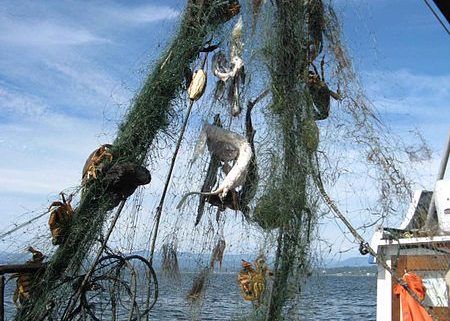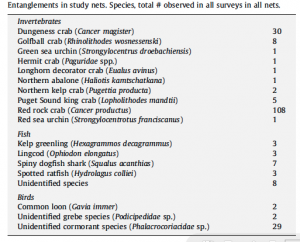A True Environmental Success Story
By Patrick Goebel, RJD Intern
The amount of derelict fishing gear lost by commercial and recreational fishing is astonishing. Derelict fishing gear includes nets, lines, crab/lobster and shrimp traps/pots, and other recreational or commercial harvest equipment that has been accidentally lost or intentionally discarded in the marine environment. In the report, A Rising Tide of Ocean Debris, volunteers collected 36,910 fishing lines, 11,059 fishing lures/light sticks, 5,539 fishing nets, and 5,285 crab/lobster traps in the United States alone in 2012.
Derelict fishing gear has the potential to continue fishing (entangling and killing marine life). This uncontrolled process is known as ghost fishing. The time and extent it fishes for depends on the type of fishing gear. The time frame, however, is getting longer and longer as highly durable fishing gear made of long-lasting synthetic material is being used. Since this gear continues to fish, there are large financial losses to the fishing industry. Ghost fishing of some commercial stocks has been estimated to catch amounts equal to 5%-30% of the annual landing levels (Laist 1995). In 2013, Puget Sound dungeness crab harvests totaled 9 million pounds. This would have resulted in 2,700,000 pounds of crab lost last year. However, that number is most likely an over estimate because of The Northwest Straits Derelict Fishing Gear Removal Program.
In 2002, the Washington State Legislature passed SB 6313, establishing the Derelict Fishing gear removal program in Puget Sound. Over the years, this program has become a true success story. The Northwest Straits Initiative (NWSI) working in cooperation with the Washington Department of Fish and Wildlife (WDFW) and the Washington Department of Natural Resources (WDNR) has developed a comprehensive derelict fishing gear removal program for Washington State (A Cost-Benefit Analysis of Derelict Fishing Gear Removal In Puget Sound, Washington). Since its creation, this program has removed 4,605 derelict fishing nets and 3,173 crab pots and 47 shrimp pots, within a depth of 105ft (~32m), from Puget Sound.
There are several reason why this program has become a true success story. The first is the process in which it was created. The legislation called for the development of a database, protocols for removal and disposal, and an evaluation of methods to reduce further losses. The first step in this process was removing any penalties associated with the reporting of lost gear. This allows gear to be removed quickly. This was so important to the program that on March 29, 2012 Gregoire signed into law Senate Bill 5561, making it mandatory for commercial fisherman to report lost nets to the Washington State Department of Fish and Wildlife within 24 hours of loss (derelictgear.org).
Locating derelict fishing gear is either done through fisherman and citizen reports or directed surveys. The surveys performed by this commission take place in areas of high commercial fishing. The program uses a high-resolution side-scan sonar survey technique, which has had a profound effect on locating derelict fishing nets and traps. At the moment removal of derelict fishing gear occurs less than 105ft deep.
The program is now in the home stretch of clearing all nets within 105ft. In 2013, the state budgeted $3.5 million dollars to ensure the completion of the project. It is their goal that they will have cleared all derelict fishing gear within 105ft from Puget Sound by 2015. There is nowhere else but up from here… Wrong… the program is heading down. There are unknown number of nets, pots and etc. in deeper water. This program is currently testing deep-water net removal strategies, such as remotely operated vehicles, grapplers, and deep-water divers. By expanding their range and removal techniques, this program can continue to lead and set an example for other programs throughout the world. The success of this program can be used to set an example for the rest of the world.
References
Laist, D.W., 1995. Marine debris entanglement and ghost fishing: A cryptic and significant type of Bycatch? Solving Bycatch. Proceedings of the Solving Bycatch Workshop, Sept. 25-27, Settle, Washington, pp: 1-1.
“A Cost-Benefit Analysis of Derelict Fishing Gear Removal In Puget Sound, Washington.” (2009): n. pag. Print. “Northwest Straits Derelict Fishing Gear Removal Program.”Northwest Straits Derelict Fishing Gear Removal Program. N.p., n.d. Web. 21 Jan. 2013. <http://www.derelictgear.org/>.
Gilardi, K. V., Carlson-Bremer, D., June, J. A., Antonelis, K., Broadhurst, G., & Cowan, T. (2010). Marine species mortality in derelict fishing nets in Puget Sound, WA and the cost/benefits of derelict net removal. Marine pollution bulletin, 60(3), 376-382.
A Rising Tide of Ocean Debris and What We Can Do about It: 2009 Report. Washington, D.C.: International Coastal Cleanup, Ocean Conservancy, 2009. Print.






Leave a Reply
Want to join the discussion?Feel free to contribute!